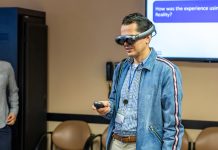
Much to our industry’s chagrin, most learners don’t describe their corporate education experiences as “valuable,” “rewarding,” or “enjoyable.” More likely, they’re associated with slide decks, classroom-style seating, and multi-tasking. Given these conditions, it’s no wonder why most learners tune out during training sessions. But it’s a missed opportunity on a staggering scale.
From the expense of hosting training events to lost productivity and the price of employee time, L&D in America costs organizations upward of $101B annually. That level of investment only makes financial sense if it translates into ROI. To achieve this, we must adjust our approach to reflect engagement, purposeful play, and talent retention insights.
Design for learners with growth mindsets
As an educator who’s interacted with more than 20K learners, I’ve found that folks possessing a growth mindset — i.e., those who view challenges as opportunities to learn and improve — are the most engaged participants in my L&D sessions. So it’s not surprising that a Stanford study found that employees with growth mindsets are more likely to stay in their jobs for longer periods than those with a fixed mindset.
Given the importance of talent retention, nurturing a growth mindset in our organizations should be a top priority. Beyond encouraging employees to build technical capabilities, offer training experiences in power skills like collaboration, resilience, and leadership. Publicly encourage people to attend these trainings and industry conferences and announce an annual budget for them.
Consider creating structured mentorship and coaching programs and communicating these opportunities to both leaders and employees. Check in quarterly with your most active learners to ascertain what they’re eager to learn next and whether your curriculum meets their skill gaps. By meeting the needs of people with growth mindsets, you’re setting a path for long-term retention of highly skilled employees.
Recognize the role of relevance
Although we spend hours developing our workshops, an audience decides in 30 seconds if the content is worth their attention. The verdict often depends on whether attendees find the first half-minute of your content relevant and engaging. Blame the Internet, but today’s audiences aren’t impressed by deep knowledge unless accompanied by context and perspective.
Lecturing is a centuries-old tradition that remains the default mode across corporate education. And while some people can learn via lecture, the content’s relevancy content appears to be the deciding factor. In fact, research finds that most humans need a personal connection to new material to absorb it effectively.
Relevance can be established by providing real-world examples of a skill or theory in action. Or by connecting the material to a local incident, current event, or social media trend. Whether you’re engaging the audience emotionally or connecting the new info with a previous lesson, effective learning happens when the learner deems the content relevant to their career or personal life.
Embrace gaming mechanics
Ever been in a session where participants were asked to wear a silly hat or join a human knot of their coworkers? Juvenile activities like these might make people roll their eyes when asked to pair up or draw an idea.
Although L&D professionals may see these “icebreakers” as a way for employees to forge instant connections, trivial games don’t just insult our intelligence; they imply that our time isn’t valuable. While facilitators are keenly focused on keeping people off their devices, participants can‘t help resenting the hours of productivity they’re losing just for the privilege of fiddling with Play-Doh during office hours.
When workplace learning is active and purposeful, however, learners are 28% more likely to retain info than in strictly passive settings. To elevate activities for a higher purpose, L&D pros must approach training from a gaming-mechanics perspective by constantly considering how to get learners engaged and keep them engaged over time. According to the experts, it’s done by gamifying skill development. More specifically, you can consciously build elements of motivation, competition, practice, and application into your L&D programs.
A game-thinking mindset requires us to consider how to present the content relevant to employees and turn learning into a game-like experience. Likewise, learners must be willing to set aside skepticism around activities requiring interaction and cooperation. Eventually, purposeful play will eclipse today’s trivial games, and learners will no longer cringe when asked to participate. Instead, they’ll come into sessions with positive experiences of learning activities that have rewarded them with deeper understanding, relevance, and skill development.
Now is the time to reimagine our approach to L&D. Instead of defaulting to monologue mode, experiment with a learner-centered experience that strives to be relevant, engaging, and welcomes spontaneous discussions. When you make decisions about curriculum, include your most active learners to ensure that you’re fostering a growth mindset and retaining valuable employees. Likewise, baking gamification elements into your L&D programs can accomplish the twin goals of knowledge retention and high employee engagement over time. By prioritizing relevance, engagement, and growth, we can transform corporate learning from an obligation into a meaningful opportunity for professional development.




